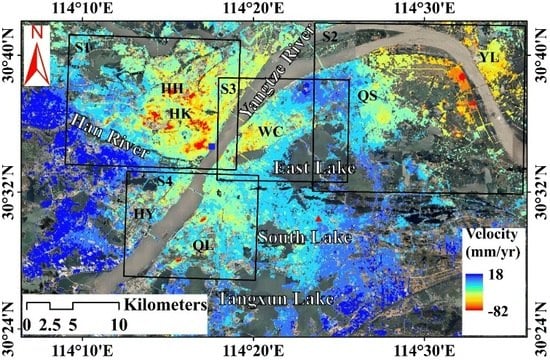Wuhan Surface Subsidence Analysis in 2015–2016 Based on Sentinel-1A Data by SBAS-InSAR
Abstract
:1. Introduction
2. Study Area and Data
2.1. Study Area
2.2. Data
3. Methodology
3.1. Fundamental Principle of SBAS-InSAR Technique
3.2. Data Processing
3.2.1. Generation of Multiple Differential Interferograms
3.2.2. Removal of Flat-Earth and Topographic Phases
3.2.3. Orbital Refinement and Phase Re-Flattening
3.2.4. Subsidence Rate and Time Series Retrieval
4. Results
4.1. Subsidence Rate Map
4.2. Subsidence Time Series
4.3. Internal Precision Checking
5. Discussion
5.1. Validation with Leveling
5.2. Surface Subsidence Associated with Urban Construction and Precipitation
5.3. Effects of Surface Subsidence coupled with Industrial Development
5.4. Correlation between Surface Subsidence and Carbonate Karstification
5.5. Comparison between Surface Subsidence Changes and Water Level Changes
6. Conclusions
- (1)
- Surface subsidence in Wuhan is remarkably uneven, and four significant subsidence areas were detected in Wuhan. These surface subsidence areas are mainly distributed in the central urban areas of Wuhan (i.e., HK and WC Districts), industrial areas in QS and YL Districts, and Baishazhou Carbonate Rock belt. Annual average subsidence rates in Wuhan range from −82 mm/year to 18 mm/year. The most serious subsidence bowl was identified in HH area with a maximum rate exceeding −80 mm/year. Additionally, surface subsidence time series shows nonlinear subsidence with pronounced seasonal variations.
- (2)
- Internal precision checking indicated that standard deviation of Sentinel-1A SBAS InSAR results in the study area is 3 mm/year, and 86.27% of the PS point standard deviations are within 6 mm/year, implying high reliability and precision of surface subsidence derived by SBAS InSAR technique using Sentinel-1A data. Results obtained by SBAS InSAR and leveling showed good agreement. Specifically, RMSE and mean error reach 6 and −1 mm/year, respectively.
- (3)
- Surface subsidence in Wuhan is seriously affected by urban construction and industrial development, and spatial distribution of subsidence bowl is relatively highly correlated to that of engineering construction and industrial areas. In addition, carbonate karstification in Wuhan also plays a significant impact factor in surface subsidence. Seasonal variations in surface subsidence are correlated to water level changes and precipitation. The GRGs between detrended subsidence and water level time series are close to 1, indicating changes of subsidence may be closely related to that of water level. However, anthropogenic activities pose more notable influence on surface subsidence in Wuhan than natural factors.
Supplementary Materials
Supplementary File 1Acknowledgments
Author Contributions
Conflicts of Interest
References
- Ge, L.; Ng, A.; Li, X.; Abidin, H.; Gumilar, I. Land subsidence characteristics of Bandung Basin as revealed by ENVISAT ASAR and ALOS PALSAR interferometry. Remote Sens. Environ. 2014, 154, 46–60. [Google Scholar] [CrossRef]
- Guo, J.M.; Zhou, L.; Yao, C.; Hu, J. Surface Subsidence Analysis by Multi-Temporal InSAR and GRACE: A Case Study in Beijing. Sensors 2016, 16, 1495. [Google Scholar] [CrossRef] [PubMed]
- Du, Z.; Ge, L.; Li, X.; Ng, A. Subsidence Monitoring over the Southern Coalfield, Australia Using both L-Band and C-Band SAR Time Series Analysis. Remote Sens. 2016, 8, 543. [Google Scholar] [CrossRef]
- Qu, F.; Zhang, Q.; Lu, Z.; Zhao, C.; Yang, C.; Zhang, J. Land subsidence and ground fissures in Xi’an, China 2005–2012 revealed by multi-band InSAR time-series analysis. Remote Sens. Environ. 2014, 155, 366–376. [Google Scholar] [CrossRef]
- Yang, H.L.; Peng, J.H. Monitoring Urban Subsidence with Multi-master Radar Interferometry Based on Coherent Targets. J. Indian Soc. Remote Sens. 2015, 43, 529–538. [Google Scholar] [CrossRef]
- Duan, G.Y.; Gong, H.L.; Liu, H.; Zhang, Y.; Chen, B.; Lei, K. Monitoring and Analysis of Land Subsidence Along Beijing-Tianjin Inter-City Railway. J. Indian Soc. Remote Sens. 2016, 44, 915–931. [Google Scholar]
- Amelung, F.; Galloway, D.L.; Bell, J.W.; Zebker, H.A.; Laczniak, R.J. Sensing the ups and downs of Las Vegas: InSAR reveals structural control of land subsidence and aquifer-system deformation. Geology 1999, 27, 483–486. [Google Scholar] [CrossRef]
- Motagh, M.; Walter, T.R.; Sharifi, M.A.; Fielding, E.; Schenk, A.; Anderssohn, J.; Zschau, J. Land subsidence in Iran caused by widespread water reservoir overexploitation. Geophys. Res. Lett. 2008, 35, L16403. [Google Scholar] [CrossRef]
- Chaussard, E.; Amelung, F.; Abidin, H.; Hong, S.H. Sinking cities in Indonesia: ALOS PALSAR detects rapid subsidence due to groundwater and gas extraction. Remote Sens. Environ. 2013, 128, 150–161. [Google Scholar] [CrossRef]
- Poland, M.; Bürgmann, R.; Dzurisin, D.; Lisowski, M.; Marsterlark, T.; Owen, S.; Fink, J. Constraints on the mechanism of long-term, steady subsidence at Medicine Lake volcano, northern California, from GPS, leveling, and InSAR. J. Volcanol. Geotherm. Res. 2006, 150, 55–78. [Google Scholar] [CrossRef]
- Baldi, P.; Casula, G.; Cenni, N.; Loddo, F.; Pesci, A. GPS-based monitoring of land subsidence in the Po Plain (Northern Italy). Earth Planet. Sci. Lett. 2009, 288, 204–212. [Google Scholar] [CrossRef]
- Carminati, E.; Martinelli, G. Subsidence rates in the Po Plain, northern Italy: the relative impact of natural and anthropogenic causation. Eng. Geol. 2002, 66, 241–255. [Google Scholar] [CrossRef]
- Psimoulis, P.; Ghilardi, M.; Fouache, E.; Stiros, S. Subsidence and evolution of the Thessaloniki plain, Greece, based on historical leveling and GPS data. Eng. Geol. 2007, 90, 55–70. [Google Scholar] [CrossRef]
- Anell, I.; Thybo, H.; Artemieva, I.M. Cenozoic uplift and subsidence in the North Atlantic region: Geological evidence revisited. Tectonophysics 2009, 474, 78–105. [Google Scholar] [CrossRef]
- Gabriel, A.K.; Goldstein, R.M.; Zebker, H.A. Mapping small elevation changes over large areas: Differential radar interferometry. J. Geophys. Res. 1989, 94, 9183–9191. [Google Scholar] [CrossRef]
- Zebker, H.A.; Villasenor, J. Decorrelation in Interferometric Radar Echoes. IEEE Trans. Geosci. Remote Sens. 1992, 30, 950–959. [Google Scholar] [CrossRef]
- Biswas, K.; Chakravarty, D.; Mitra, P.; Misra, A. Spatial-Correlation Based Persistent Scatterer Interferometric Study for Ground Deformation. J. Indian Soc. Remote Sens. 2017, 45, 1–14. [Google Scholar] [CrossRef]
- Hanssen, R.F. Radar Interferometry Data Interpretation and Error Analysis, 1st ed.; Springer: Berlin, Germany, 2001. [Google Scholar]
- Ferretti, A.; Savio, G.; Barzaghi, R.; Borghi, A.; Musazzi, S.; Novali, F.; Prati, C.; Rocca, F. Submillimeter accuracy of InSAR time series: Experimental validation. IEEE Trans. Geosci. Remote Sens. 2007, 45, 1142–1153. [Google Scholar] [CrossRef]
- Vajedian, S.; Motagh, M.; Nilfouroushan, F. StaMPS improvement for deformation analysis in mountainous regions: Implications for the Damavand volcano and Mosha fault in Alborz. Remote Sens. 2015, 7, 8323–8347. [Google Scholar] [CrossRef]
- Zhang, L.; Ding, X.; Lu, Z. Modeling PSInSAR time series without phase unwrapping. IEEE Trans. Geosci. Remote Sens. 2011, 49, 547–556. [Google Scholar] [CrossRef]
- Ferretti, A.; Prati, C.; Rocca, F. Permanent scatterers in SAR interferometry. IEEE Trans. Geosci. Remote Sens. 2001, 39, 8–20. [Google Scholar] [CrossRef]
- Beradino, P.; Fornaro, G.; Lanari, R.; Sansosti, E. A new algorithm for Surface deformation monitoring based on small baseline differential SAR interferograms. IEEE Trans. Geosci. Remote Sens. 2002, 40, 2375–2383. [Google Scholar] [CrossRef]
- Lanari, R.; Mora, O.; Manunta, M.; Mallorquí, J.J.; Beradino, P.; Sansosti, E. A small-baseline approach for investigating deformations on full-resolution differential SAR interferograms. IEEE Trans. Geosci. Remote Sens. 2004, 42, 1377–1386. [Google Scholar] [CrossRef]
- Hooper, A. A multi-temporal InSAR method incorporating both persistent scatterer and small baseline approaches. Geophys. Res. Lett. 2008, 30, L16302. [Google Scholar] [CrossRef]
- Zhang, L.; Ding, X.; Lu, Z. Ground settlement monitoring based on temporarily coherent points between two SAR acquisitions. ISPRS J. Photogramm. 2011, 66, 146–152. [Google Scholar] [CrossRef]
- Perissin, D.; Wang, T. Repeat-pass SAR interferometry with partially coherent targets. IEEE Trans. Geosci. Remote Sens. 2011, 50, 271–280. [Google Scholar] [CrossRef]
- Bateson, L.; Cigna, F.; Boon, D.; Sowter, A. The application of the Intermittent SBAS (ISBAS) InSAR method to the South Wales Coalfield, UK. Int. J. Appl. Earth Obs. Geoinf. 2015, 34, 249–257. [Google Scholar] [CrossRef] [Green Version]
- Chen, B.; Gong, H.; Li, X.; Lei, K.; Zhu, L.; Gao, M.; Zhou, C. Characterization and causes of land subsidence in Beijing, China. Int. J. Remote Sens. 2017, 38, 808–826. [Google Scholar] [CrossRef]
- Castellazzi, P.; Arroyo-Domínguez, N.; Martel, R.; Calderhead, A.; Normand, J.; Gárfias, J.; Rivera, A. Land subsidence in major cities of Central Mexico: Interpreting InSAR-derived land subsidence mapping with hydrogeological data. Int. J. Appl. Earth Obs. Geoinf. 2016, 47, 102–111. [Google Scholar] [CrossRef]
- Le, T.; Chang, C.P.; Nguyen, X.; Yhokha, A. TerraSAR-X Data for High-Precision Land Subsidence Monitoring: A Case Study in the Historical Centre of Hanoi, Vietnam. Remote Sens. 2016, 8, 338. [Google Scholar] [CrossRef]
- Dong, S.; Samsonov, S.; Yin, H.; Ye, S.; Cao, Y. Time-series analysis of subsidence associated with rapid urbanization in Shanghai, China measured with SBAS InSAR method. Environ. Earth Sci. 2014, 72, 677–691. [Google Scholar] [CrossRef]
- Wu, J.; Hu, F. Monitoring Ground Subsidence along the Shanghai Maglev Zone Using TerraSAR-X Images. IEEE Geosci. Remote Sens. 2017, 14, 117–121. [Google Scholar] [CrossRef]
- Liu, X.; Cao, Q.; Xiong, Z.; Yin, H.; Xiao, G. Application of small baseline subsets D-InSAR technique to estimate time series land deformation of Jinan area, China. J. Appl. Remote Sens. 2016, 10, 026014. [Google Scholar] [CrossRef]
- Bai, L.; Jiang, L.; Wang, H.; Wang, H.; Sun, Q. Spatiotemporal Characterization of Land Subsidence and Uplift (2009–2010) over Wuhan in Central China Revealed by TerraSAR-X InSAR Analysis. Remote Sens. 2016, 8, 350. [Google Scholar] [CrossRef]
- Fan, S. A Discussion on Karst Collapse in Wuhan (Hubei). Resour. Environ. Eng. 2006, 20, 608–616. [Google Scholar]
- Luo, X. Division of “Six Belts and Five Types” of carbonate region and control of karst geological disaster in Wuhan. J. Hydraul. Eng. 2014, 45, 171–179. [Google Scholar]
- Costantini, M.; Bai, J.; Malvarosa, F.; Minati, F.; Vecchioli, F.; Wang, R.; Hu, Q.; Xiao, J.; Li, J. Ground deformations and building stability monitoring by COSMO-SkyMed PSP SAR interferometry: Results and validation with field measurements and surveys. In Proceedings of the IGARSS 2016—IEEE International Geoscience and Remote Sensing Symposium, Beijing, China, 10–15 July 2016. [Google Scholar]
- Velotto, D.; Bentes, C.; Tings, B.; Lehner, S. First Comparison of Sentinel-1 and TerraSAR-X Data in the Framework of Maritime Targets Detection: South Italy Case. IEEE J. Ocean. Eng. 2016, 41, 993–1006. [Google Scholar] [CrossRef]
- Sowter, A.; Amat, M.B.C.; Cigna, F.; Marsh, S.; Athab, A.; Alshammari, L. Mexico City land subsidence in 2014–2015 with Sentinel-1 IW TOPS: Results using the Intermittent SBAS (ISBAS) technique. Int. J. Appl. Earth Obs. Geoinf. 2016, 52, 230–242. [Google Scholar] [CrossRef]
- Nannini, M.; Prats-Iraola, P.; Zan, F.D.; Geudtner, D. TOPS Time Series Performance Assessment with TerraSAR-X Data. IEEE J. Sel. Top. Appl. Earth Obs. Remote Sens. 2016, 9, 3832–3848. [Google Scholar] [CrossRef]
- Hu, B.; Wang, H.; Sun, Y.; Hou, J.; Liang, J. Land-term land subsidence monitoring of Beijing (China) using the Small Baseline Subset (SBAS) technique. Remote Sens. 2014, 6, 3648–3661. [Google Scholar] [CrossRef]
- Hooper, A.; Segall, P.; Zebker, H. Persistent scatterer interferometric synthetic aperture radar for crustal deformation analysis, with application to Volcán Alcedo, Galápagos. J. Geophys. Res. Atmos. 2007, 112, B07407. [Google Scholar] [CrossRef]
- Casu, F.; Manzo, M.; Lanari, R. A quantitative assessment of the SBAS algorithm performance for surface deformation retrieval from DInSAR data. Remote Sens. Environ. 2006, 102, 195–210. [Google Scholar] [CrossRef]
- Goldstein, R.M.; Werner, C.L. Radar interferogram filtering for geophysical applications. Geophys. Res. Lett. 1998, 25, 4035–4038. [Google Scholar] [CrossRef]
- Ferretti, A.; Prati, C.; Rocca, F. Nonlinear subsidence rate estimation using permanent scatterers in differential SAR interferometry. IEEE Trans. Geosci. Remote Sens. 2000, 38, 2202–2212. [Google Scholar] [CrossRef]
- Luo, Q.L.; Perissin, D.; Zhang, Y.; Jia, Y. L- and X-Band Multi-Temporal InSAR Analysis of Tianjin Subsidence. Remote Sens. 2014, 6, 7933–7951. [Google Scholar] [CrossRef]
- Zhang, Y.; Wu, H.; Kang, Y.; Zhu, C. Ground Subsidence in the Beijing-Tianjin-Hebei Region from 1992 to 2014 Revealed by Multiple SAR Stacks. Remote Sens. 2016, 8, 675. [Google Scholar] [CrossRef]
- Wu, C. Study and analysis of settlement in the estate of Houhu, Wuhan. Technol. Innov. Appl. 2014, 22, 216. [Google Scholar]
- Zhong, Y.; Zhang, M.K.; Pan, L.; Zhao, S.K.; Hao, Y.H. Risk Assessment for Urban Karst Collapse in Wuchang District of Wuhan Based on GIS. J. Tianjin Norm. Univ. (Nat. Sci. Ed.) 2015, 35, 48–53. [Google Scholar]
- Xu, G. Mechanism Study and Hazard Assessment of Cover Karst Sinkholes in Wuhan City, China. Ph.D. Thesis, China University of Geosciences, Wuhan, China, 2016. [Google Scholar]
- Luo, X.J. Features of the shallow karst development and control of karst collapse in Wuhan. Carsologica China 2013, 32, 419–432. [Google Scholar]
- Deng, J. The GRA in Cause-Effect Space of Resources. J. Grey Syst. 2009, 21, 113–119. [Google Scholar]
- Deng, J. To Analyze the Connotation and Extension (C & E) of Grey Theory. J. Grey Syst. 2012, 24, 293–298. [Google Scholar]
- Ip, W.C.; Hu, B.Q.; Wong, H.; Xia, J. Applications of grey relational method to river environment quality evaluation in China. J. Hydrol. 2009, 379, 284–290. [Google Scholar] [CrossRef]
- Wei, G.W. Gray Relational Analysis Method For Intuitionistic Fuzzy Multiple Attribute Decision Making. Expert Syst. Appl. 2011, 38, 11671–11677. [Google Scholar] [CrossRef]
- Du, J.C.; Kuo, M.F. Grey relational-regression analysis for hot mix asphalt design. Constr. Build. Mater. 2011, 25, 2627–2634. [Google Scholar] [CrossRef]
- Mu, R.; Zhang, J.T. Research of hierarchy synthetic evaluation based on grey relational analysis. Syst. Eng. Theor. Prac. 2008, 28, 125–130. [Google Scholar]


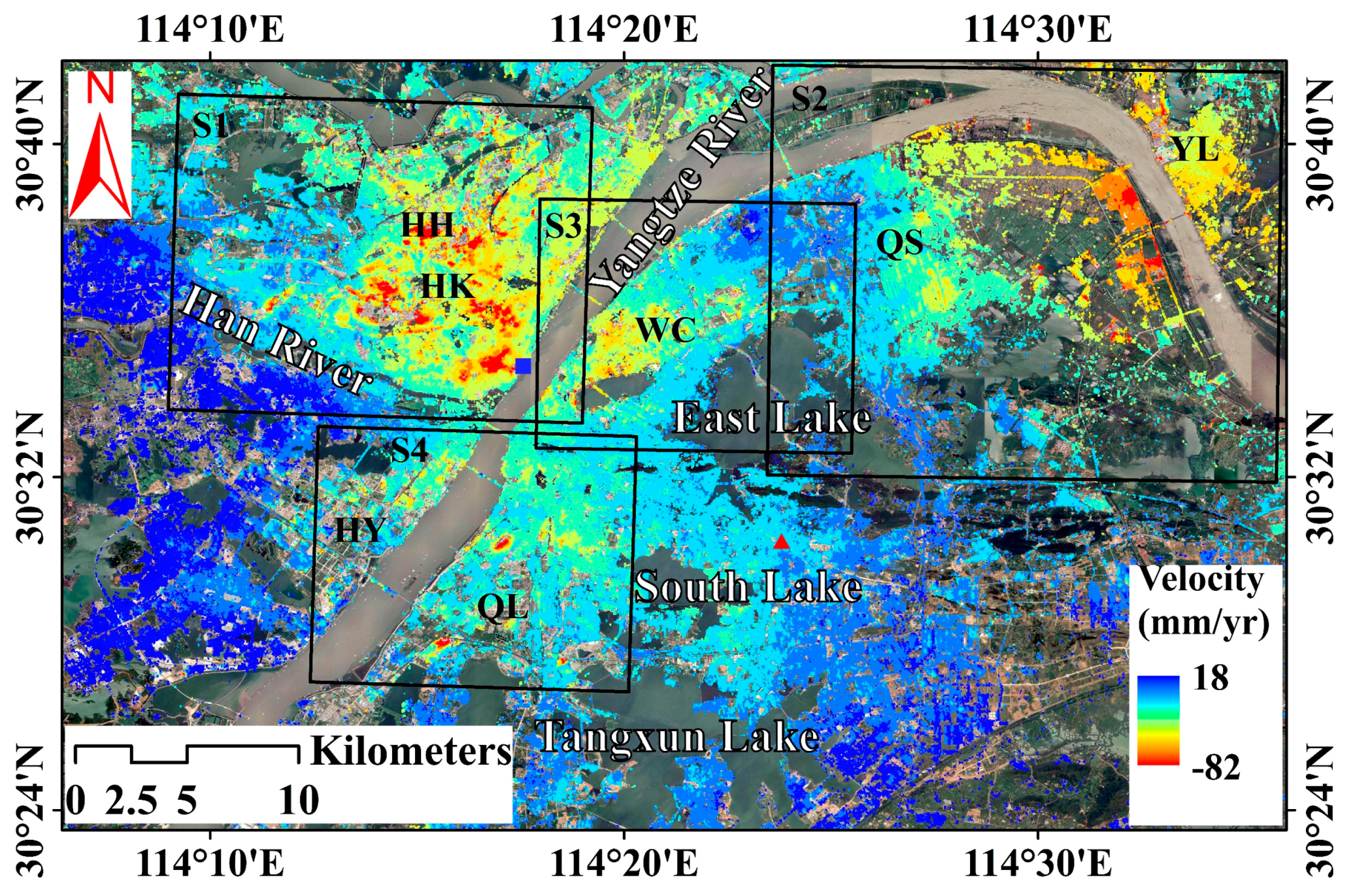
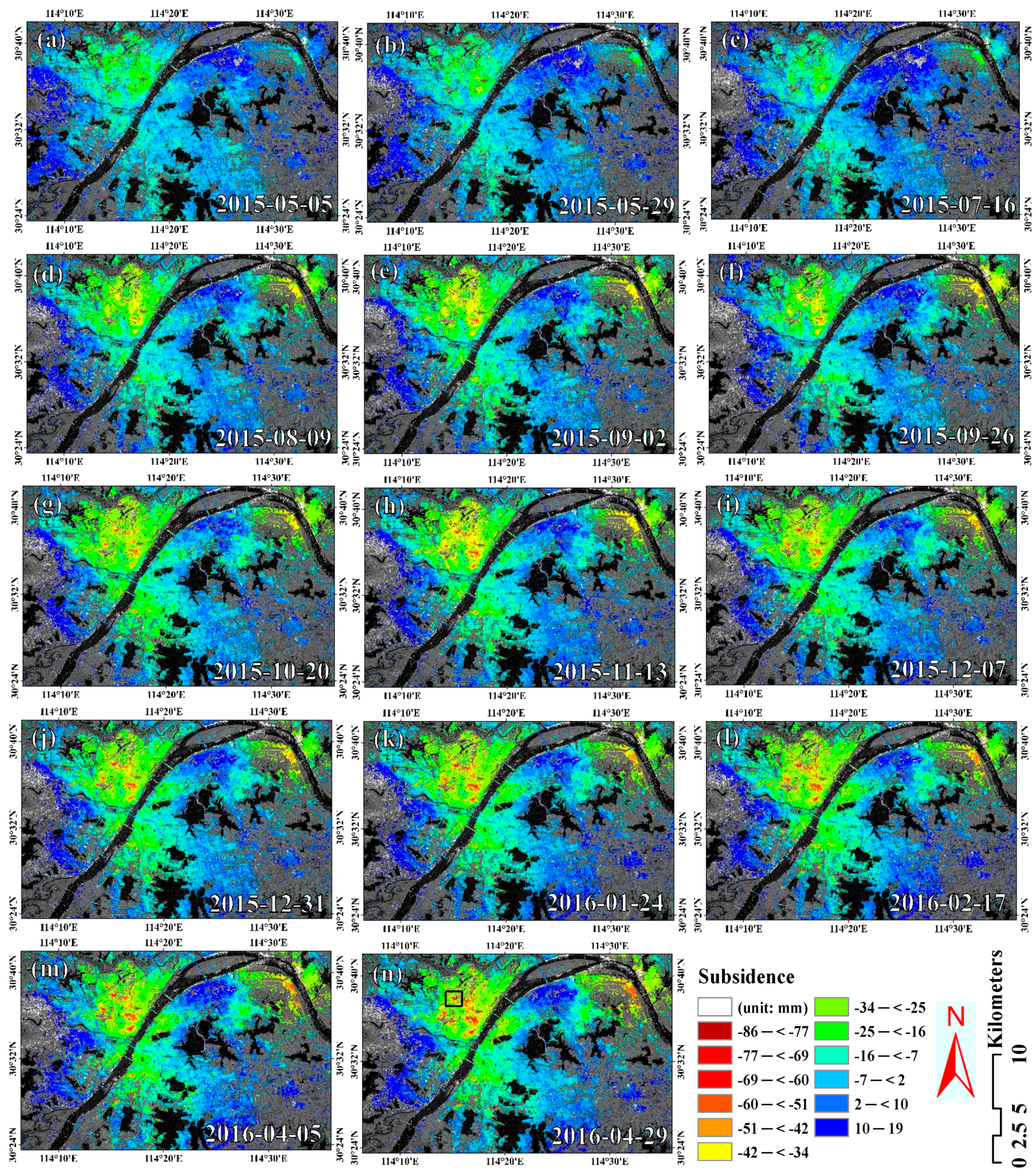

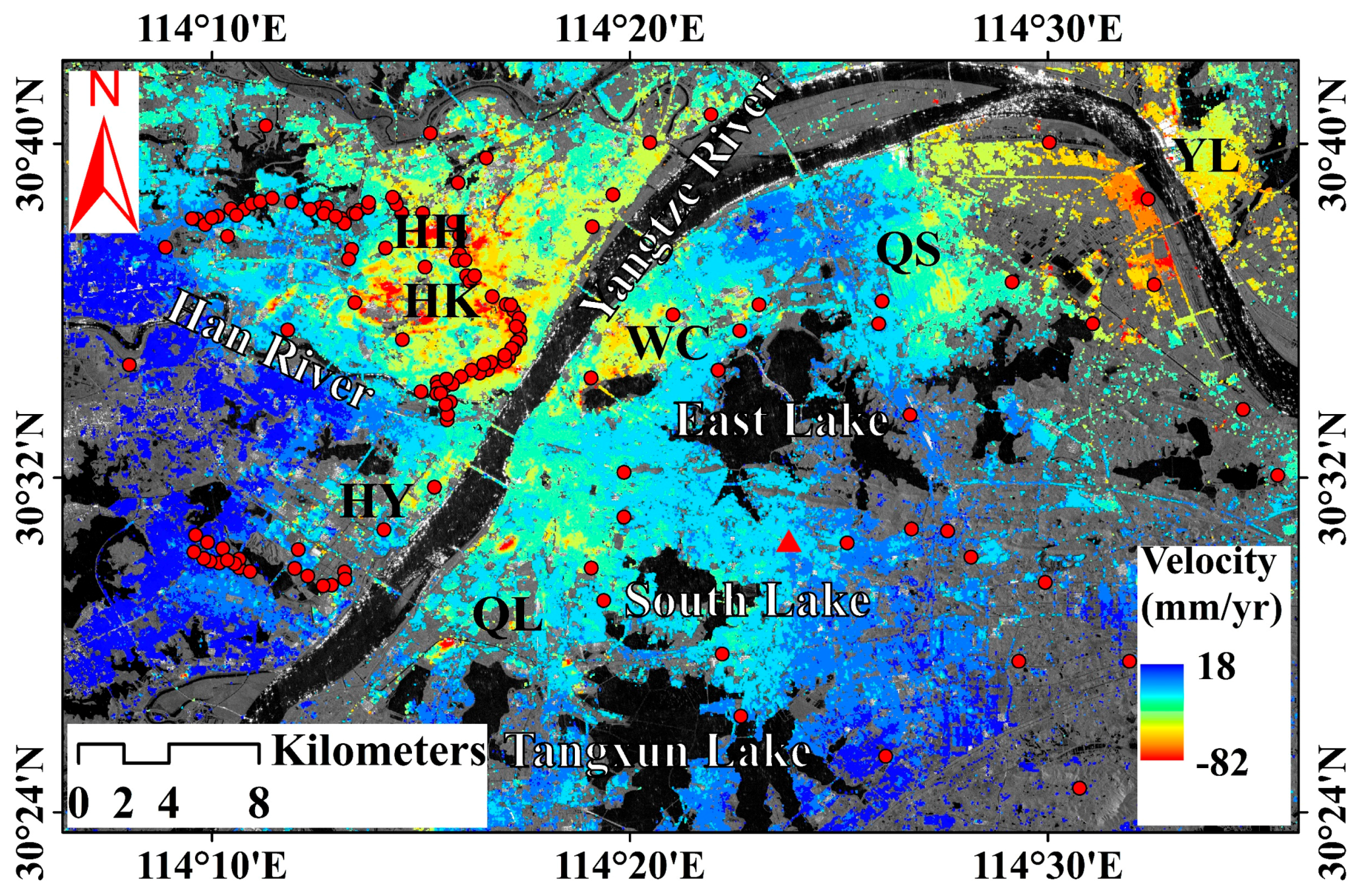
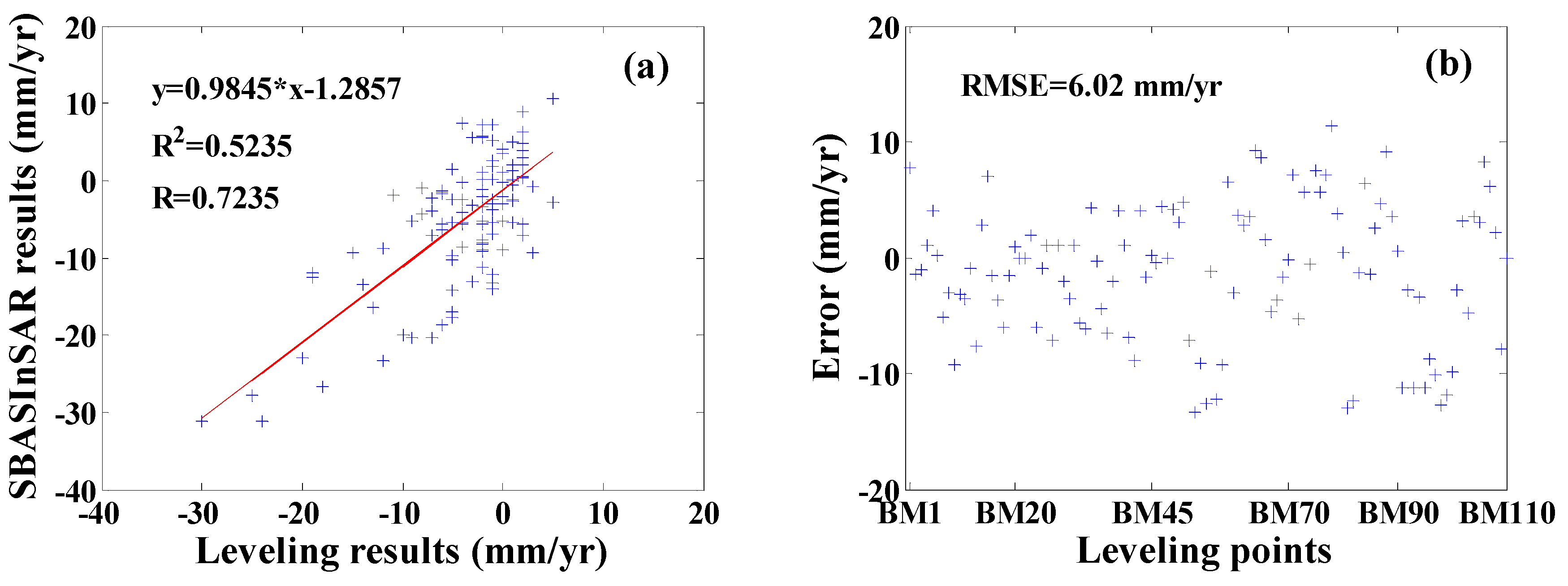


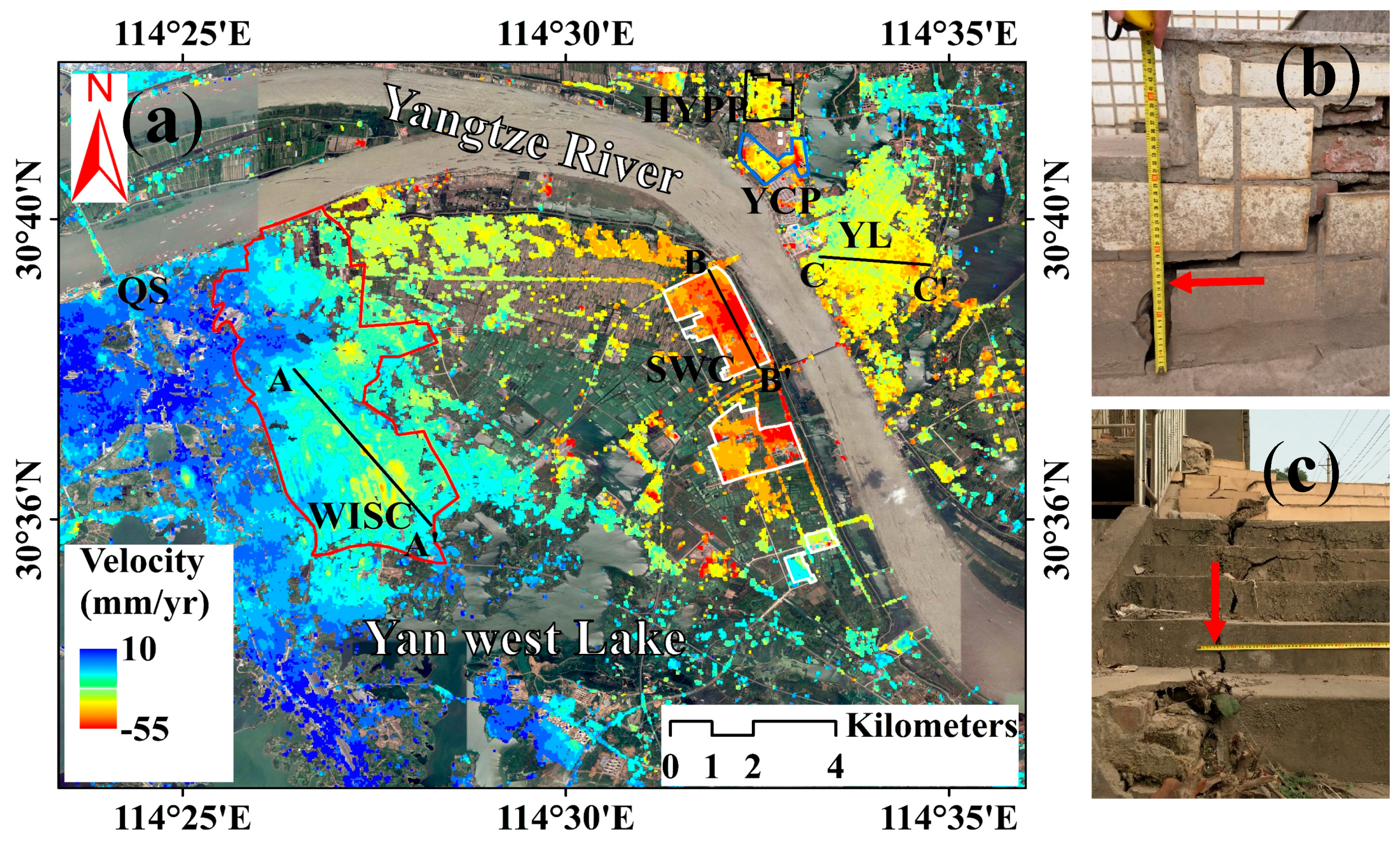


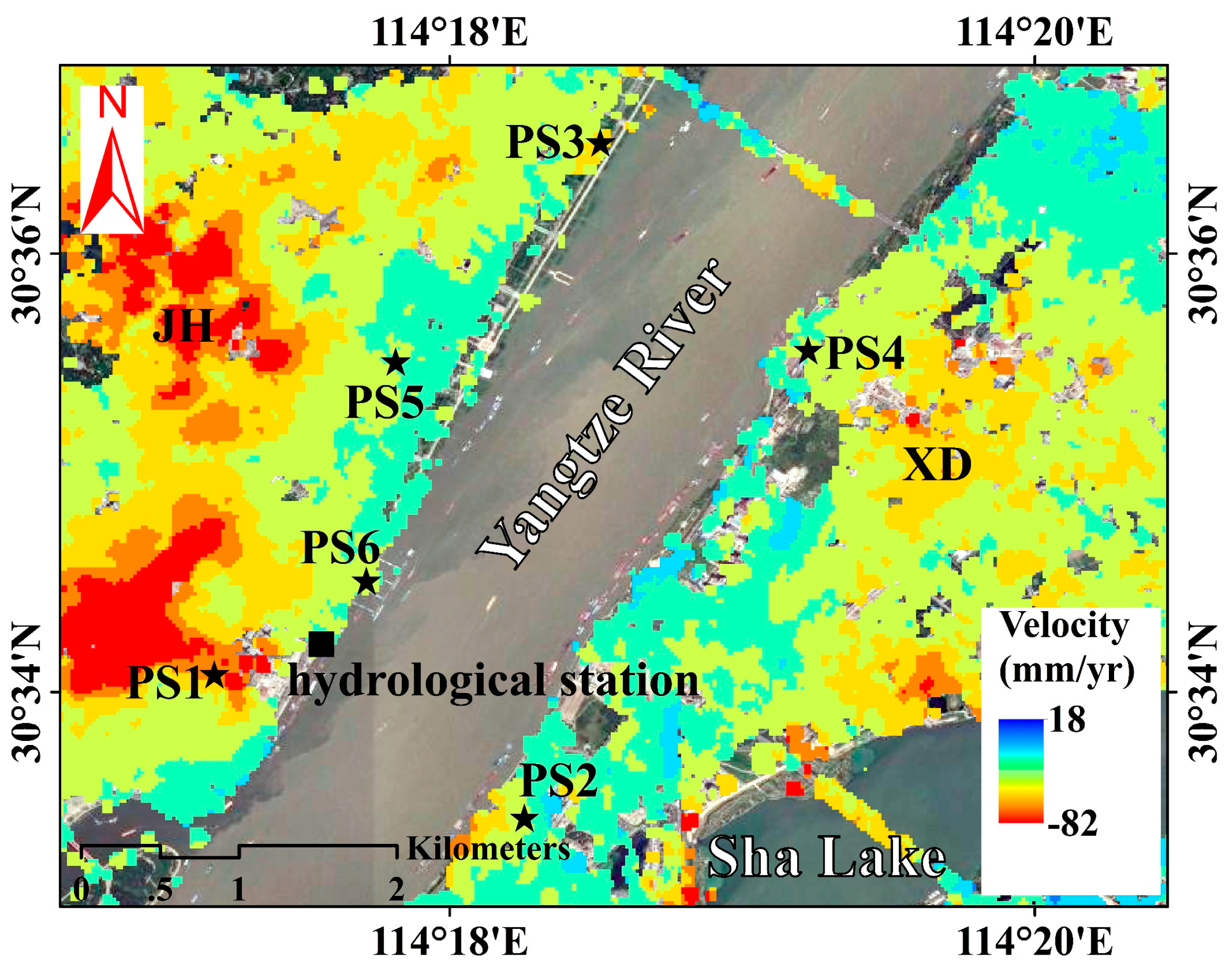

| Parameters | Description |
|---|---|
| Product type | Sentinel1 SLC IW |
| Track number | 113 |
| Central incidence angle on the test site (degree) | 41.9 |
| Azimuth angle (degree) | 90 |
| Slant range resolution (m) | 2.3 |
| Azimuth resolution (m) | 13.9 |
| Orbit direction | Ascending |
| Polarization | VV |
| Method | Mean Error | RMSE | MAX Error | MIN Error |
|---|---|---|---|---|
| Kriging | −1 | 6 | 11 | −13 |
| PS Points | GRG | Standard Deviation | |
|---|---|---|---|
| Time Series | Detrended Time Series | Displacement (mm) | |
| PS1 | 0.82 | 0.92 | 1.2 |
| PS2 | 0.91 | 0.97 | 0.7 |
| PS3 | 0.87 | 0.96 | 0.7 |
| PS4 | 0.88 | 0.94 | 1.1 |
| PS5 | 0.92 | 0.96 | 1.1 |
| PS6 | 0.88 | 0.96 | 1.4 |
© 2017 by the authors. Licensee MDPI, Basel, Switzerland. This article is an open access article distributed under the terms and conditions of the Creative Commons Attribution (CC BY) license (http://creativecommons.org/licenses/by/4.0/).
Share and Cite
Zhou, L.; Guo, J.; Hu, J.; Li, J.; Xu, Y.; Pan, Y.; Shi, M. Wuhan Surface Subsidence Analysis in 2015–2016 Based on Sentinel-1A Data by SBAS-InSAR. Remote Sens. 2017, 9, 982. https://doi.org/10.3390/rs9100982
Zhou L, Guo J, Hu J, Li J, Xu Y, Pan Y, Shi M. Wuhan Surface Subsidence Analysis in 2015–2016 Based on Sentinel-1A Data by SBAS-InSAR. Remote Sensing. 2017; 9(10):982. https://doi.org/10.3390/rs9100982
Chicago/Turabian StyleZhou, Lv, Jiming Guo, Jiyuan Hu, Jiangwei Li, Yongfeng Xu, Yuanjin Pan, and Miao Shi. 2017. "Wuhan Surface Subsidence Analysis in 2015–2016 Based on Sentinel-1A Data by SBAS-InSAR" Remote Sensing 9, no. 10: 982. https://doi.org/10.3390/rs9100982




